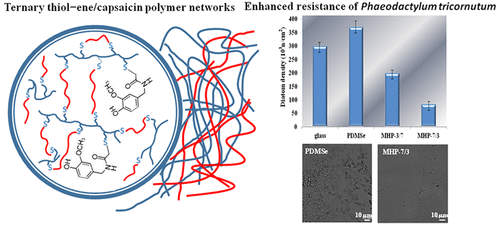Our official English website, www.x-mol.net, welcomes your
feedback! (Note: you will need to create a separate account there.)
Capsaicin-Inspired Thiol–Ene Terpolymer Networks Designed for Antibiofouling Coatings
Langmuir ( IF 3.7 ) Pub Date : 2017-11-16 00:00:00 , DOI: 10.1021/acs.langmuir.7b03098 Haiye Wang 1, 2 , Joshua Jasensky 2 , Nathan W. Ulrich 2 , Junjie Cheng 2 , Hao Huang 2 , Zhan Chen 2 , Chunju He 1
Langmuir ( IF 3.7 ) Pub Date : 2017-11-16 00:00:00 , DOI: 10.1021/acs.langmuir.7b03098 Haiye Wang 1, 2 , Joshua Jasensky 2 , Nathan W. Ulrich 2 , Junjie Cheng 2 , Hao Huang 2 , Zhan Chen 2 , Chunju He 1
Affiliation

|
Novel photocurable ternary polymer networks were prepared by incorporating N-(4-hydroxy-3-methoxybenzyl)-acrylamide (HMBA) into a cross-linked thiol–ene network based on poly(ethylene glycol)diacrylate (PEGDA) and (mercaptopropyl)methylsiloxane homopolymers (MSHP). The ternary network materials displayed bactericidal activity against Escherichia coli and Staphylococcus aureus and reduced the attachment of marine organism Phaeodactylum tricornutum. Extensive soaking of the polymer networks in aqueous solution indicated that no active antibacterial component leached out of the materials, and thus the ternary thiol–ene coating killed the bacteria by surface contact. The surface structures of the polymer networks with varied content ratios were studied by sum frequency generation (SFG) vibrational spectroscopy. The results demonstrated that the PDMS Si-CH3 groups and mimic-capsaicine groups are predominantly present at the polymer–air interface of the coatings. Surface reorganization was apparent after polymers were placed in contact with D2O: the hydrophobic PDMS Si-CH3 groups left the surface and returned to the bulk of the polymer networks, and the hydrophilic PEG chains cover the polymer surfaces in D2O. The capasaicine methoxy groups are able to segregate to the surface in an aqueous environment, depending upon the ratio of HMBA/PEGDA. SFG measurements in situ showed that the antibacterial HMBA chains, rather than the nonfouling PEG, played a dominant role in mediating the antibiofouling performance in this particular polymer system.
中文翻译:

辣椒素启发的硫醇-烯三元共聚物网络,专为抗污垢涂料而设计
通过将N-(4-羟基-3-甲氧基苄基)-丙烯酰胺(HMBA)掺入基于聚(乙二醇)二丙烯酸酯(PEGDA)和(巯基丙基)甲基硅氧烷的交联硫醇-烯网络中,制备了新型光固化三元聚合物网络均聚物(MSHP)。三元网络材料显示出对大肠杆菌和金黄色葡萄球菌的杀菌活性,并减少了海洋生物三角藻Phaeodactylum tricornutum的附着。聚合物网络在水溶液中的大量浸泡表明,没有活性的抗菌成分从材料中浸出,因此三元硫醇-烯涂层通过表面接触杀死了细菌。通过和频产生(SFG)振动光谱研究了含量比变化的聚合物网络的表面结构。结果表明,PDMS Si-CH 3基团和模拟辣椒碱基团主要存在于涂层的聚合物-空气界面。聚合物与D 2 O接触后表面重组明显:疏水性PDMS Si-CH 3基团离开表面并返回到大部分聚合物网络中,亲水性PEG链覆盖了D 2 O中的聚合物表面。在水环境中,Capasaicine甲氧基能够离析至表面,具体取决于HMBA的比例/ PEGDA。SFG原位测量表明,在这种特定的聚合物系统中,抗菌HMBA链而不是不结垢PEG在介导抗生物结垢性能方面起着主导作用。
更新日期:2017-11-16
中文翻译:

辣椒素启发的硫醇-烯三元共聚物网络,专为抗污垢涂料而设计
通过将N-(4-羟基-3-甲氧基苄基)-丙烯酰胺(HMBA)掺入基于聚(乙二醇)二丙烯酸酯(PEGDA)和(巯基丙基)甲基硅氧烷的交联硫醇-烯网络中,制备了新型光固化三元聚合物网络均聚物(MSHP)。三元网络材料显示出对大肠杆菌和金黄色葡萄球菌的杀菌活性,并减少了海洋生物三角藻Phaeodactylum tricornutum的附着。聚合物网络在水溶液中的大量浸泡表明,没有活性的抗菌成分从材料中浸出,因此三元硫醇-烯涂层通过表面接触杀死了细菌。通过和频产生(SFG)振动光谱研究了含量比变化的聚合物网络的表面结构。结果表明,PDMS Si-CH 3基团和模拟辣椒碱基团主要存在于涂层的聚合物-空气界面。聚合物与D 2 O接触后表面重组明显:疏水性PDMS Si-CH 3基团离开表面并返回到大部分聚合物网络中,亲水性PEG链覆盖了D 2 O中的聚合物表面。在水环境中,Capasaicine甲氧基能够离析至表面,具体取决于HMBA的比例/ PEGDA。SFG原位测量表明,在这种特定的聚合物系统中,抗菌HMBA链而不是不结垢PEG在介导抗生物结垢性能方面起着主导作用。











































 京公网安备 11010802027423号
京公网安备 11010802027423号